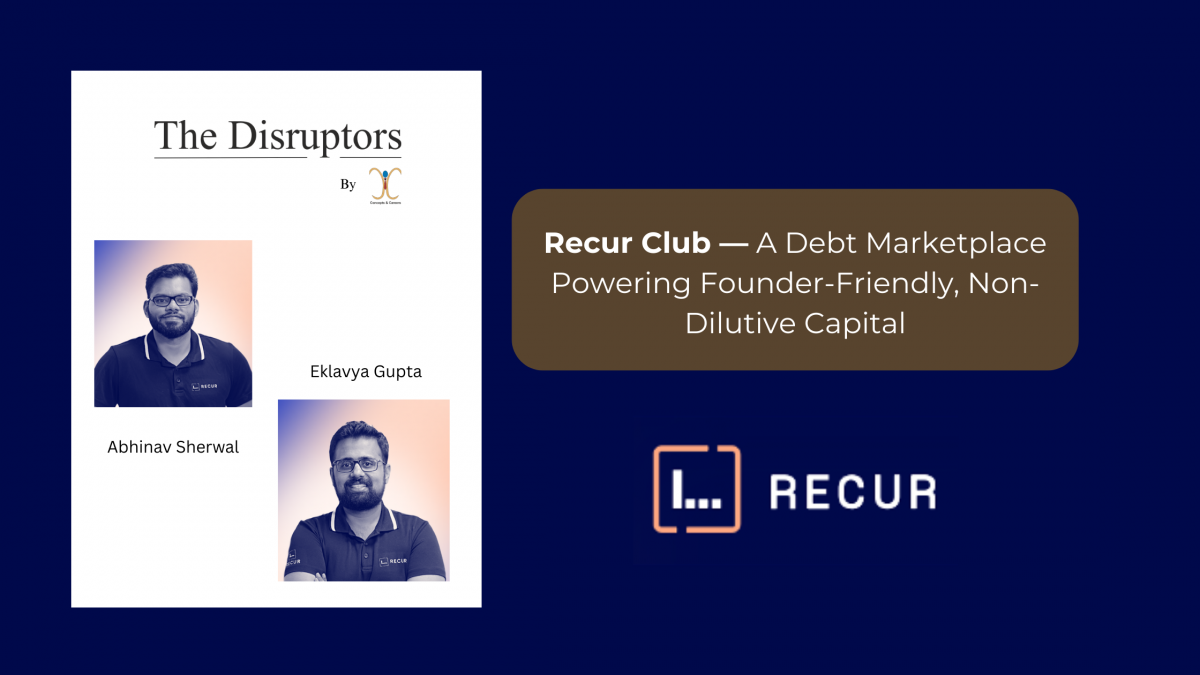- Have any questions?
- [email protected]
The Disruptor: Recur Club — A Debt Marketplace Powering Founder-Friendly, Non-Dilutive Capital

Unraveling the Business Acumen of Baniyas: A Deep Dive into “Rokda: How Baniyas Do Business” by Nikhil Inamdar
August 27, 2025
Unveiling the Legacy of Marwaris: A Deep Dive into “The Marwaris” by Thomas A. Timberg
September 3, 2025Lead: Venture markets can be slow, equity is expensive, and bank credit rarely fits the speed or shape of a startup’s cash flows. Recur Club is attacking that gap with a tech-first debt marketplace and revenue-based financing (RBF) rails that give recurring-revenue companies working capital in days—without equity dilution. Founded by Eklavya Gupta and Abhinav Sherwal, the Delhi-based company blends underwriting models, on-platform guidance, and structured products so founders can scale while preserving ownership.
What Recur Club Does (Journalist’s lens)
At its core, Recur Club is a debt marketplace: startups and SMEs plug in billing, banking, and revenue data; an underwriting engine and capital experts shape the right facility; disbursal happens quickly, with transparent terms and programmatic repayments. The platform supports collateral-free business loans for MSMEs, unsecured term loans for startups, and secured loans for larger companies—positioned as a faster, more data-driven alternative to traditional credit. The company cites 2,000+ customers/partners and ₹2,000 crore+ capital disbursed.
A key pillar is Revenue-Based Financing: advance a portion of predictable future revenues and repay as a share of monthly collections, aligning cash outflows to inflows. Recur Club highlights 48-hour approvals, founder-friendly terms (no equity, no collateral), and suitability for subscription/SaaS and other recurring-revenue businesses.
Products & Programs (Product manager’s lens)
- Recur Scale — a larger facility (reportedly up to ₹100 crore per company) aimed at startups/SMEs that have meaningful revenue traction; designed for scale-up, inventory, and marketing needs.
- Recur Swift — quicker, smaller lines that prioritize speed and repeat access to working capital for MSMEs.
- Guided Capital — each company is paired with a capital expert to choose structures (term loans, RBF, secured options) that match runway, CAC–payback, and seasonality.
Why it matters: these instruments let founders finance customer acquisition, inventory, and receivables without giving up board seats or months in diligence—especially valuable when equity markets tighten. (For context, RBF is now a mainstream option in India’s funding mix.)
How the Model Works (Risk & underwriting lens)
- Data pipeline: connect revenue/billing, banking, and commerce systems to build a live cash-flow view.
- Underwriting: pattern-recognition on retention, cohort stability, gross margins, and concentration risk; facilities sized against ARR/MRR quality and cash conversion.
- Programmatic repayments: fixed-percentage sweeps from collections (for RBF) or scheduled EMIs (for term loans) keep debt service aligned to growth cycles.
Founder fit: best for companies with predictable collections and clear CAC→LTV math (SaaS, D2C with repeat purchase, logistics enablement, B2B commerce). Less ideal for pre-revenue or lumpy, project-based cash flows. (Independent analyses describe Recur Club as an automated exchange advancing a share of ARR with 6–24 month paybacks.)
Traction, Initiatives & Ecosystem Role (Analyst’s lens)
- Deployment intent: Recent reports indicate Recur Club aims to deploy ₹2,000 crore to startups/SMEs via Recur Scale, plus ₹1,000 crore to MSMEs via Recur Swift in the current financial cycle—signaling balance-sheet depth and lender partnerships.
- Crisis response: During the Silicon Valley Bank turmoil, Recur Club created a $15M emergency pool for Indian founders—evidence of platform agility and ecosystem orientation.
- Funding backdrop: Public trackers show a mix of seed and debt rounds; totals vary by source (e.g., Tracxn lists $7.25M to date across rounds; other databases show higher figures, likely including debt facilities). The takeaway: access to both equity and credit lines underpins product expansion.
Go-to-Market Playbook (Operator’s lens)
- Acquire with speed: promise of 48-hour approvals and transparent pricing drives high-intent inbound; capital experts reduce friction for first-time borrowers.
- Win on outcomes: position capital against measurable goals—e.g., “fund 3 months of CAC,” “double inventory turns for Q-commerce,” “bridge receivables for enterprise SaaS.”
- Retain via loops: repeat top-ups when cohorts perform; embed light analytics so founders see how debt boosted growth KPIs (MRR, LTV/CAC, payback).
- De-risk via structure: align repayment cadence to revenue volatility (RBF for variable inflows, term loans when predictability is high).
Competitive Context (Market lens)
India’s non-dilutive capital landscape includes RBF players and fintech lenders. Recur Club’s edge is the multi-product debt marketplace (RBF + term + secured), guided underwriting, and growing deployment capacity—useful in equity-tight cycles. Risks remain: macro credit shocks, fraud risk in connected data, and over-extension of borrowers. Mitigations are stronger data plumbing, concentration limits, and education on leverage discipline.
Founder Snapshot (People lens)
- Eklavya Gupta (Co-founder & Co-CEO) — investor-turned-entrepreneur; NSIT (Engg), IIM Calcutta (MBA); prior stints across capital markets, PE, and structured credit at Nomura, Kotak, BofA–Merrill Lynch, and Ivanhoe Cambridge (CDPQ). Focus: product, underwriting philosophy, and ecosystem partnerships.
- Abhinav Sherwal (Co-founder & Co-CEO) — co-founded Recur Club and leads marketplace building and operations; public materials and reviews reference his co-leadership on products and capital stacks.
Why Recur Club is a Disruptor
Because it changes the default: founders no longer have to choose between dilutive equity or slow bank credit. With data-driven underwriting and repayment tied to revenue health, Recur Club helps teams pull forward growth while preserving ownership—a structural shift with outsized impact in emerging markets where credit access is uneven.





